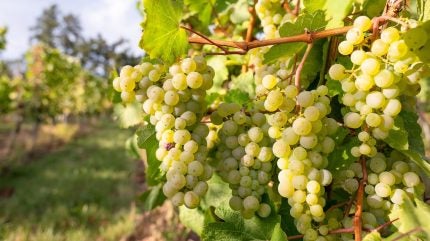
Improved weather conditions are set to boost Germany’s wine harvest this year, with volumes up on 2024.
The Federal Statistical Office (Destatis) estimates this year’s wine output will total 8.2m hectolitres as of 20 September 2025, up 5% on 2024’s 7.8m hectolitres.

Discover B2B Marketing That Performs
Combine business intelligence and editorial excellence to reach engaged professionals across 36 leading media platforms.
Last year’s harvest was hit by adverse weather, including late frosts and heavy rainfall, and came in 12% below the 2018–2023 six-year average of 8.9m hectolitres.
Growing conditions in 2025 were generally more favourable, although the crop is still expected to be slightly below average – 3% under the 2019–2024 six-year benchmark of 8.5m hectolitres, Destatis said.
Last month, Germany urged Brussels to expand its planned grub-up scheme as the bloc tries to support a sector facing falling consumption.
The practices of grubbing-up and green harvesting – which would see winemakers removing unripe grapes before harvest – are designed to prevent surplus production.

US Tariffs are shifting - will you react or anticipate?
Don’t let policy changes catch you off guard. Stay proactive with real-time data and expert analysis.
By GlobalDataSuch moves have been carried out in individual EU member states and Brussels said in March it would look to “empower” countries to carry out similar schemes.
In June, the European Council, the EU institution composed of the 27 member state governments, gave its backing to the package, albeit with suggested changes in other areas including labelling and rules for no-and-low wines.
However, in a submission to the EU’s Agriculture and Fisheries Council, the German government has suggested Brussels should go further on grubbing-up.
Rheinhessen and Pfalz wine regions are again set to account for just over half of total output, with 2.2m and 2m hectolitres respectively.
Baden (1.2m hectolitres) and Württemberg (911,000 hectolitres) together are forecast to contribute a further 26%.
Across Germany’s wine regions, most areas are projected to post year-on-year growth.
Baden is set to add 232,000 hectolitres, an increase of 24%, while Württemberg is expected to rise by 231,000 hectolitres, up 34%.
The Mosel shows a rebound with an additional 228,000 hectolitres, equating to a 44% uplift.
Franconia and Nahe are both forecast to expand by around a third, with gains of 96,000 hectolitres and 76,000 hectolitres respectively, each up 30%.
The sharpest relative increase is anticipated in Saale-Unstrut, where volumes are predicted to climb by 46,000 hectolitres, a jump of 275%.
By contrast, Rheinhessen is forecast to fall by 371,000 hectolitres, a decline of 14%, while the Palatinate/Pfalz is projected to drop by 240,000 hectolitres, down 11%.
The Rheingau is set for a smaller reduction of 15,000 hectolitres, equivalent to 7%.
White wines are expected to make up the bulk of the 2025 harvest, with 5.7m hectolitres (69%) of white must and 2.6m hectolitres (31%) of red must.
White production will dominate in Mosel (90%), Rheingau (86%), and Franconia (85%).
In August, a newly founded winegrowing association warned up to half of Germany’s family-owned wine companies are at risk if consumers do not start buying more locally produced wine.
Per capita wine consumption in the country stood at 22.2 litres in 2024, down 0.3 litres on a year earlier, with drinkers reportedly only consuming eight litres of German wine on average.
“Without immediate countermeasures, up to 50% of winegrowing families in Germany face economic ruin within a few weeks,” Thomas Schaurer, founder of the Zukunftsinitiative Deutscher Weinbau, told Just Drinks.





